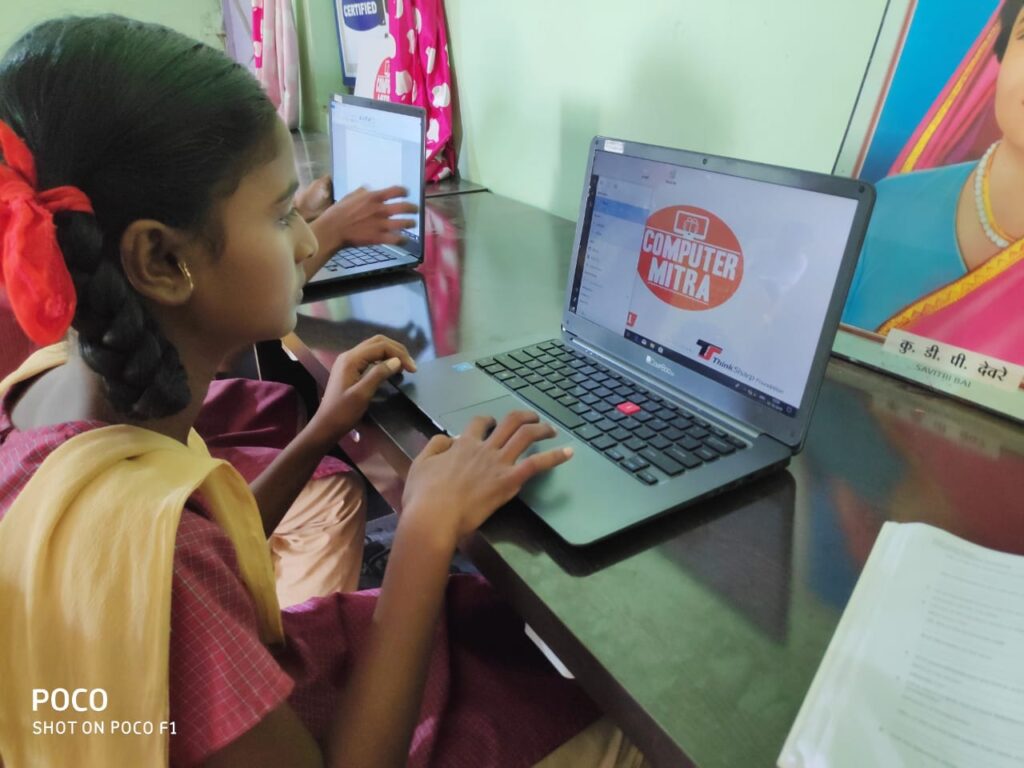
Summary
E-learning, youtube, emails, Zoom, Google meet, screen share, Google drive- Who isn’t aware of the new lingos that came into our everyday language after 2020? From preschoolers to doctorate students everyone is dependent on digital devices to learn, grow and socialize. There are multiple factors contributing to computer literacy among school students including the curriculum, infrastructure, tutors, evaluation system etc. This study focuses on determining the computer literacy level particularly among Government school teachers in rural Maharashtra.
The research was conducted by the Young Changemakers – Diya Dhyani, Satchidanand Radhesh, Muhammad Asjad, and Lakshya Arora from TribesforGood for Thinksharp Foundation in order to establish adequate systems to better Computer Education in the state of Maharashtra. Through the study, there were several correlations between the teaching resources, skillset, and infrastructure. It was found that only 31% of the teachers were comfortable using digital means of teaching in spite of the fact that they use computers/ laptops multiple times a week. Though only a minority of 15% lacked basic computer knowledge, the need for training was quite evident among all the teachers. Digital tools like Powerpoint, Excel, Word, Creative apps, Video creating apps, etc could significantly widen the skill set of the teachers.
Another factor contributing to the digital divide is the poor infrastructure and broken curriculum in these schools. It was found that 58% of schools didn’t have computer education as part of their curriculum. Unfortunately, the remaining 42% were also found to be in unsatisfactory condition with a poor Student- Device ratio.
The study is trying to highlight the need of the hour to make computer education easily accessible to students at least till secondary school.
Objectives
- To understand computer literacy levels and computer skills of teachers from rural Government schools in Maharashtra
- To understand the accessibility of computers for students in such schools
Methodology
The research was conducted by the high school students from TribesforGood as part of a grassroot level study for Thinksharp Foundation. The target group for this research was the teachers from Government schools in rural areas like Badapokharan, Jambargaon, Raigad, etc.
- Understanding the existing education system in Maharashtra through secondary research
- Identifying the schools and teachers for primary data collection
- Preparation of questionnaires with relevant questions and translating them into Marathi for the ease of understanding
- Primary data collection through phone interviews and Video calls
- Analysis of the collected data to form Key Findings
*Limitations of the study: There were 27 respondents from different districts across Maharashtra. Though this can give us an overview of the issue in hand, it might be difficult to come to general conclusions.
Analysis
The research involved 27 teachers from different schools across Maharashtra. Marathi Vidya Mandir- Bastwad, Zilla Parishad School- Badapokharan, Zilla Parishad Primary School- Jambargaon, Raigad Sikha Parishad Upper- Primary School Vakas were some of the schools that took part in the survey. Out of the respondents, 78% were directly involved in teaching Computer Science at their respective schools. However, it was found that only 8% of them were appointed as dedicated Computer Science teachers.


The majority of the teachers (65%) were using computers/laptops multiple times in a week and day. This denotes good exposure to digital devices. However, the comfort level of using these devices were not found adequate.


While a significant number of teachers operate MS Office applications with some level of comfort (around 89%), only 40% of them use those applications to make teaching content without any help.
At the same time, Emails and Google Drive storage were found to be commonly used by the teachers. Around 90% of the teachers were familiar with emails whereas 65% were comfortable with google drive.

Looking at the skewed results of computer skills and comfort, we can assume that there is a lack of a training system in place for the teachers. Only 69% of the respondents have received some form of computer training, 31% have received no training at all.

The second half of the study focused on the infrastructural facilities and curriculum in these schools. Though 85% of schools have working computers, only 14% of them have 5 or more devices which shows a low student to computer ratio. Furthermore, only a minuscule 15% of the schools have a stable internet connection.
(Note: The number of computers could be deceiving here as these devices could be used for administrative purposes as well)

Even in schools with computer devices, the percentage of students who are able to access them is only 12%. This number could also be due to the fact that computer education is not a part of the students’ curriculum as per 58% of the respondents.

In schools where Computer Science is a part of the curriculum, it is introduced from 5th to 7th grade in 80% of the cases. However, only 39% of them have teachers who teach only Computer Science to the students which is concerning.
According to the teachers, there is a lot of perceived curiosity among students to learn computer skills (92 percent) and they believe that computer education will increase the job prospects of the students.
Thus, there is a need for proper computer education across schools and more devices for students to be able to use them.
Recommendations
When we look at the results which came out of the primary research, we can clearly see the need for a systematic training method for the teachers. Since Computer Education is not part of the curriculum, additional classes to introduce the students to the basics of computer science would also be a starting point. However, for this to happen multiple devices or a better device sharing mechanism needs to be developed.
(515)
